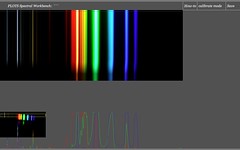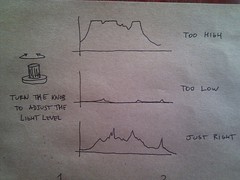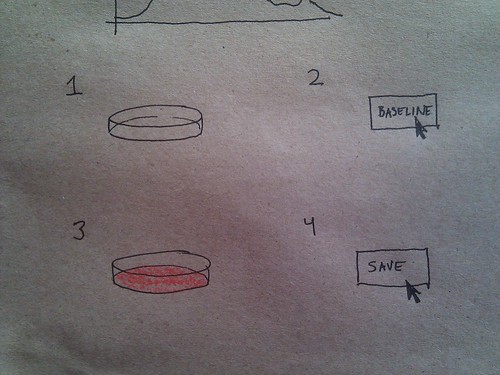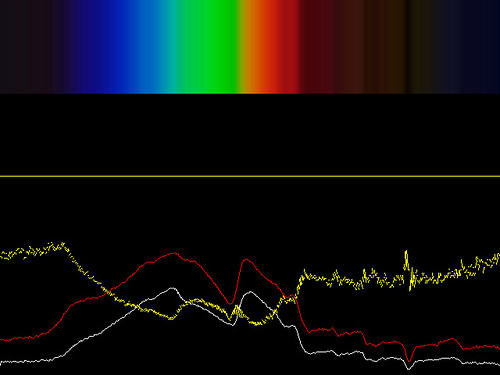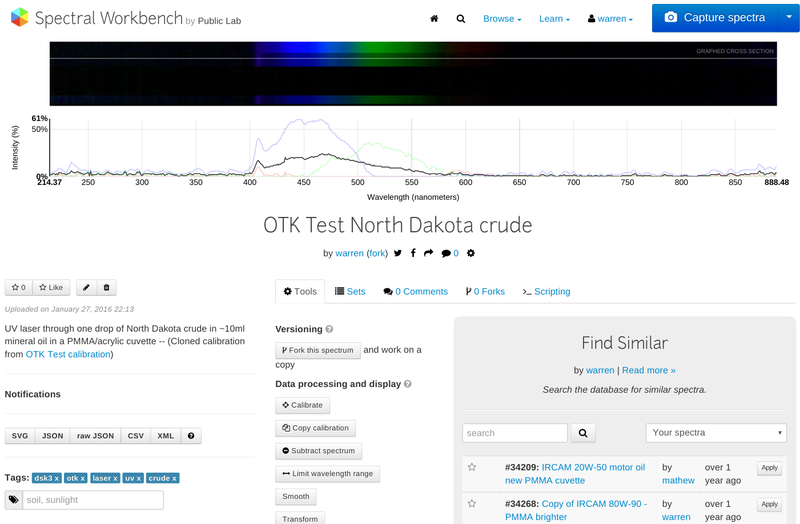
Spectral Workbench usage
Basics
Quick start
SpectralWorkbench.org is a web-based software suite for collecting spectra, using your Public Lab DIY spectrometer. Once you have an assembled spectrometer connected to your computer or smartphone, go to https://spectralworkbench.org and click Capture.
To use the full functionality, and especially on iOS, you should first log in using your PublicLaboratory.org username.
You'll then be able to connect to your spectrometer (desktop or Opera Mobile) or upload a spectrum. Give it a title, tags, and description.
Calibration
You'll notice that many other spectra on the site have a scale showing "nm" or nanometer units on the horizontal axis. To get scaled data, you must calibrate your spectrometer. There are several kinds of calibration but here we're talking about wavelength calibration, which allows your spectrometer to display a wavelength value for any color of light it sees. Luckily, this is easy.
1) Find a fluorescent light bulb -- preferably a compact fluorescent bulb you can put your spectrometer very close to. Point your spectrometer at the bulb -- if it's too bright, point it at a piece of white paper or wall which is brightly illuminated by the bulb.

2) You'll see an image like the above example; if you're on a computer, it may appear horizontally. The lines you see are from mercury in the bulb, and since we know what wavelengths they should be, we can use this to calibrate your device.
Save this spectrum, and tag it "fluorescent". Now you'll need to use the analysis tool to calibrate; it will walk you through the process.
Videos
A brief intro to Spectral Workbench's new web-based capture interface, including absorption spectroscopy:
Calibration
Learn to calibrate your spectrometer with a compact fluorescent light (CFL):
See Spectral Workbench Help if you have trouble.
Note: The above video walks through this process and is more up to date. The following instructions are for the older, deprecated version of Spectral Workbench
Older versions of Spectral Workbench
The older, downloadable client for Spectral Workbench.
Configuring your webcam
You can skip this step, but it may be harder to compare baseline readings. Most webcams have auto exposure and color "correction" so that in dim light, you can still see. This will unfortunately change the exposure between readings, so for quantitative work, it must be disabled. On Linux, you can use the "uvcdynctl" utility as outlined here.
On a Mac, you can download this utility: http://www.phoboslab.org/log/2009/07/uvc-camera-control-for-mac-os-x
Launching the application
Once you have downloaded the software, you should be able to open the "application.macosx" folder and double click spectral_workbench.
Mac: First you will be prompted to select a camera. Choose the webcam associated with your spectrometer, which may be "Creative Webcam Live ..." if you bought the video spectrometer kit. Select "None" under Compression.
Linux users may experience trouble if they do not have a built-in webcam; if you are comfortable coding you can change the line "new Video(x,x,x,1);" to "new Video(x,x,x,0);" which will select the first camera, not the second one.
Basics
The software has 3 "modes" -- Setup, Analyze, and Heatmap. Setup lets you properly configure your spectrometer before using it. Analyze is the main mode you'll be using when testing samples. Heatmap uses a color gradient to display finer differences in your spectra, and is otherwise the same as Analyze.
Setup
Click the "Setup" tab at the top. You will see a small "preview" window indicating the height of the sampling row. You can drag to select the area you'd like to sample from, which will be averaged to produce your spectral data.
This is a chance to adjust the amount of light you're using as your source. If you have a dimmer, turn the dial until the red, green, and blue intensity curves are full height, but not "hitting the ceiling" -- which would mean you were losing data due to overexposure.
(see plans for improvement)
Store a baseline reading
Now that your spectrometer is set up correctly, you can store a "baseline" reading of just your sample container with no sample material. Place your sample container between the light and your spectrometer and press the spacebar. The spectrum you were seeing should be "saved" as a red line which persists even if you remove the sample container.
Measuring a sample
Now place the sample in its container in front of the spectrometer. You should see the white line drop below the red line - this is because your sample is absorbing some of the light. A new, yellow line will appear, representing the amount of absorption.
Saving a spectrum
Before saving, name your spectra by typing a name. It will appear in the top bar. Press "Save" and the SpectralWorkbench.org website will open in a window and prompt you to log in and save your data.
For some, the "Save" function is not working properly, and although the data is uploaded, it is not attached to your account. To get around this, you can open the "spectra" folder which you will find in the same folder as your application. There you will find any spectra which you have saved, which you can upload directly at SpectralWorkbench.org. (read about this bug here)
